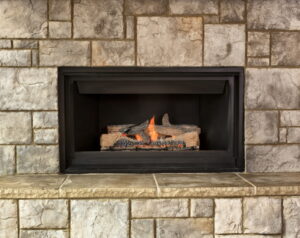A wood-burning fireplace is romantic and lovely, gives your home a cozy atmosphere, and provides a place to warm your hands when you’re chilly. But it also creates a lot of mess: soot, ashes, sawdust, bits of bark. Is it worth it for that homey feel?
What if we told you that your wood-burning fireplace is also extremely inefficient? Spending a lot on wood for your fireplace and getting hardly any heat for your money is outrageous. Gas fireplaces are much more efficient. Here’s how.
The Inefficiency of Burning Wood
The sad fact is that wood-burning fireplaces are a terrible way to heat your home. They’re often used mostly for aesthetics, but if you’re using fuel, you want to get something out of it. The exact efficiency depends on a wide variety of factors like the age of the fireplace and how well-insulated your home is, but most estimates fall between ten and twenty-five percent.
The Efficiency of Burning Gas
Gas-burning fireplaces come in a variety of models, and again, the level of insulation in your home is still a factor. However, the lowest estimates of gas fireplace efficiency are far higher than you would ever see with a wood-burning fireplace, around fifty to sixty percent. In an ideal situation, with professional installation of a carefully-selected model, efficiency can be ninety percent.
What the Percentages Mean
Heating efficiency is calculated by measuring two things: the energy used by a form of heating apparatus and the amount of heat that apparatus produces. When expressed as a percentage, it is essentially showing how much of the energy being used actually becomes heat. This means that with a wood-burning fireplace, 75 to 90% of the energy you’re paying for will not become warmth in your home.
What Causes the Efficiency Difference
The technology used in wood-burning fireplaces is literally ancient. The fire requires oxygen to burn, which it gets by pulling cool air down the chimney. As the cool air goes down, heated air goes up, escaping and being lost. Modern technology allows gas fireplaces to vent the carbon monoxide and dioxide safely out of your home without letting all the heat escape with it.
The Money You Could Save
The amount you spend on wood for your fireplace can vary a lot, depending on where you live and how much you use your fireplace, but national averages indicate that people with fireplaces spend around $350 per year on wood. In contrast, people with gas-burning fireplaces spend, on average, about $100 per year fueling their fireplaces.
Choosing a Gas Fireplace
Many options are available. Different installation processes are required depending on whether you’re converting a wood-burning fireplace or a woodstove’s chimney or are adding a fireplace where none existed before. It’s critical to have the help of an experienced professional when you’re ready for gas fireplace installation in Short Hills, NJ.
Established in 1912, Max Sr & Paul Schoenwalder Plumbing, Heating and Air Conditioning, A Corp. is your trusted resource for knowledgeable gas fireplace installation. Reach out to us today.

